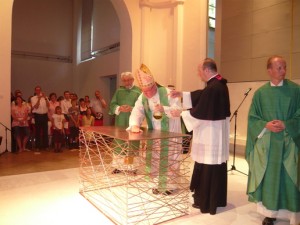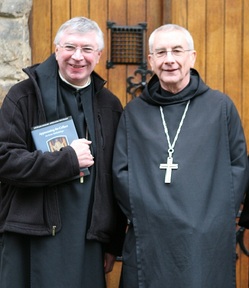Recently, the Congregation for Divine Worship and the Discipline of the Sacraments published a Circular Letter entitled “The Ritual Expression of the Gift of Peace at Mass” (July 8, 2014). Pope Francis approved and ordered its publication. The letter deals with the question of the Sign of Peace resolving the question whether the Holy See would move the Sign of Peace to an earlier part in the Mass; a question bantered around by liturgists for years. As a note, the Eastern Churches place the Sign of Peace before the Eucharistic prayer; I am speaking about the Western Church here.
At the 2005 Synod of Bishops on the Eucharist, the synod fathers raised the question of the moving of the Sign of Peace because of the perceived disruption of what the Sign of Peace has become. Pope emeritus Benedict XVI noted in his Post-Synodal Apostolic Exhortation Sacramentum caritas (2007), stated:
“[D]uring the Synod of Bishops there was discussion about the appropriateness of greater restraint in this gesture, which can be exaggerated and cause a certain distraction in the assembly just before the reception of Communion. It should be kept in mind that nothing is lost when the sign of peace is marked by a sobriety which preserves the proper spirit of the celebration, as, for example, when it is restricted to one’s immediate neighbors.”
The Church made the decision to leave the Sign of Peace where it is. The Letter explains:
In the Roman liturgical tradition, the exchange of peace is placed before Holy Communion with its own specific theological significance. Its point of reference is found in the Eucharistic contemplation of the Paschal mystery as the “Paschal kiss” of the Risen Christ present on the altar as in contradistinction to that done by other liturgical traditions which are inspired by the Gospel passage from St. Matthew (cf. Mt 5: 23: “So if you are offering your gift at the altar, and there remember that your brother has something against you, leave your gift before the altar and go; first be reconciled to your brother, and then come and offer your gift”).
The ritual gesture needs to cohere with the theology. The Church makes a crucial distinction that we need to be aware of: the sign of peace at Mass refers to the Risen Christ’s gift of His peace, it is paschal in nature. The fitting-ness of this rite is placed just before the moment when Jesus will feed His people with His own Body and Blood in Holy Communion. Jesus Christ is our peace, and only from Him is our peace known, lived and an invitation to our conversion. The sign of peace, as a minor rite in the Mass, must reflect this divine gift and not distract us as we prepare to receive that gift of Christ’s peace in the Holy Eucharist. The exchange of peace in many places is done with a superficial and sentimental bearing no mind to who is before us.
Too often the sign of peace is a breaking of contemplation, a turning away from the Eucharistic Lord present before us on the altar; too often the focus is on the person and community.
Now with the Circular Letter the application of the rite calls for the need to be reverent and sober in the exchange of a sign of the Lord’s peace. It gives “practical guidelines. . .to better explain the content of the exchange of peace and to moderate excessive expressions that give rise to disarray in the liturgical assembly before Communion.”
Moreover: “If it is foreseen that it will not take place properly due to specific circumstances or if it is not considered pedagogically wise to carry it out on certain occasions, it can be omitted, and sometimes ought to be omitted. It is worth recalling that the rubric from the Missal states: ‘Then, if appropriate, the Deacon of the Priest, adds: Let us offer each other the sign of peace.’”
The Sign of Peace, therefore, is not required at Mass. The Holy See is clearly concerned that this optional rite has become the occasion for all sorts of problems and distractions. The Letter lists “abuses” that we must “definitively avoid”: singing a song of peace during the exchange of the sign of peace, people moving around the church to exchange the sign of peace with others, the priest leaving the altar to give the sign of peace to the faithful in the pews, and the not uncommon practice of using the sign of peace at special Masses such as weddings or funerals as an “occasion for expressing congratulations, best wishes or condolences among those present.”
The faithful accustomed to a more free manner of the sign of peace will say that “this is a key moment of connection with others at Mass, it helps to focus on what we are doing, I like saying hello to my friends, and meeting new people,” or some such thing. At a local parish the people are now waving at each other, which is yet another problem. While all of these things are good, they are not fitting in the praying of the Mass. Let me say decisively, we are not under attack from Rome; we are asked to consider what we are doing, why we are doing it, and to be coherent in liturgical practice and tradition.
Liturgical order in Mass is important in the worship of God. I have come to worship the Trinity; not to be distracted.

